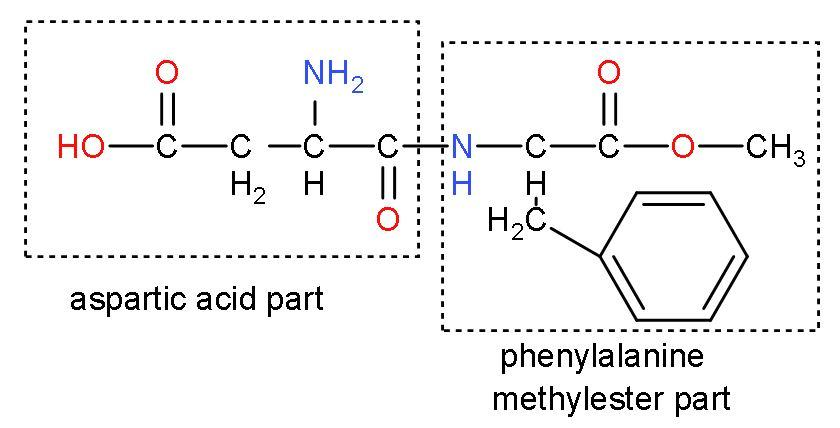Answer
394.5k+ views
Hint: Aspartame is an example of artificial sweetening agent. Such substances are added to increase shelf life of stored food or cosmetic purposes. These agents do not have any nutritional value. These substances have high sweetness in comparison to cane sugar but low calories.
Complete answer:
Let us discuss the structure of aspartame and its properties to understand the reason for this question;
Aspartame: It is a methyl ester of the dipeptide of the natural amino acids which are L-aspartic acid and L-phenylalanine.

- Under acidic or alkaline conditions, aspartame generates methanol by hydrolysis. Under more conditions, the peptide bonds are also hydrolyzed, resulting in free amino acids.
- Aspartame is 100 times as sweet as sucrose. As aspartame produces 17 kJ of energy per gram when metabolised. The amount of aspartame needed to produce a sweet taste is so small that its caloric count is almost negligible.
- Aspartame decomposes at cooking on high temperature.
The correct answer to this question is option ‘a’ which says that use of aspartame is limited to cold foods and soft drinks because it is unstable at cooking temperature.
So, the correct answer is “Option A”.
Additional Information:
(1)- Use of aspartame has severe effects and causes risk of headaches, depression, dizziness and attention deficit hyperactivity disorder (ADHD).
(2) Aspartame is denoted as E951. Aspartame stimulates the taste buds on the tongue as it is a sugar substitute. It is used in a variety of desserts, sweets, foods, beverages, chewing gums and weight-control products.
(3) Artificial sweetener is associated with long-term weight gain and increased risk of diabetes, high blood pressure and heart disease. Consumption of aspartame is increasing.
Note: The structure of aspartame is almost similar to sucralose, so do not get confused between the properties of the two. Sucralose is a trichloro derivative of sucrose. It tastes like sugar. It is stable at cooking temperature and it does not provide calories.
Complete answer:
Let us discuss the structure of aspartame and its properties to understand the reason for this question;
Aspartame: It is a methyl ester of the dipeptide of the natural amino acids which are L-aspartic acid and L-phenylalanine.

- Under acidic or alkaline conditions, aspartame generates methanol by hydrolysis. Under more conditions, the peptide bonds are also hydrolyzed, resulting in free amino acids.
- Aspartame is 100 times as sweet as sucrose. As aspartame produces 17 kJ of energy per gram when metabolised. The amount of aspartame needed to produce a sweet taste is so small that its caloric count is almost negligible.
- Aspartame decomposes at cooking on high temperature.
The correct answer to this question is option ‘a’ which says that use of aspartame is limited to cold foods and soft drinks because it is unstable at cooking temperature.
So, the correct answer is “Option A”.
Additional Information:
(1)- Use of aspartame has severe effects and causes risk of headaches, depression, dizziness and attention deficit hyperactivity disorder (ADHD).
(2) Aspartame is denoted as E951. Aspartame stimulates the taste buds on the tongue as it is a sugar substitute. It is used in a variety of desserts, sweets, foods, beverages, chewing gums and weight-control products.
(3) Artificial sweetener is associated with long-term weight gain and increased risk of diabetes, high blood pressure and heart disease. Consumption of aspartame is increasing.
Note: The structure of aspartame is almost similar to sucralose, so do not get confused between the properties of the two. Sucralose is a trichloro derivative of sucrose. It tastes like sugar. It is stable at cooking temperature and it does not provide calories.
Recently Updated Pages
Basicity of sulphurous acid and sulphuric acid are

Three beakers labelled as A B and C each containing 25 mL of water were taken A small amount of NaOH anhydrous CuSO4 and NaCl were added to the beakers A B and C respectively It was observed that there was an increase in the temperature of the solutions contained in beakers A and B whereas in case of beaker C the temperature of the solution falls Which one of the following statements isarecorrect i In beakers A and B exothermic process has occurred ii In beakers A and B endothermic process has occurred iii In beaker C exothermic process has occurred iv In beaker C endothermic process has occurred

What is the stopping potential when the metal with class 12 physics JEE_Main

The momentum of a photon is 2 times 10 16gm cmsec Its class 12 physics JEE_Main

How do you arrange NH4 + BF3 H2O C2H2 in increasing class 11 chemistry CBSE

Is H mCT and q mCT the same thing If so which is more class 11 chemistry CBSE

Trending doubts
State the differences between manure and fertilize class 8 biology CBSE

Why are xylem and phloem called complex tissues aBoth class 11 biology CBSE

Difference between Prokaryotic cell and Eukaryotic class 11 biology CBSE

Difference Between Plant Cell and Animal Cell

What would happen if plasma membrane ruptures or breaks class 11 biology CBSE

Give 10 examples for herbs , shrubs , climbers , creepers

What precautions do you take while observing the nucleus class 11 biology CBSE

What would happen to the life of a cell if there was class 11 biology CBSE

Change the following sentences into negative and interrogative class 10 english CBSE



